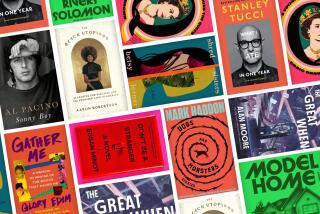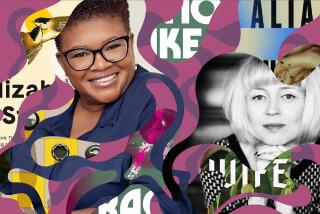MAGAZINES / 1990 IN REVIEW : The Good, the Bad and the Ludicrous
- Share via
The 1980s were boom years for magazines. More than 3,000 new titles sprang from the giddy era of celebrity worship and unbridled business optimism.
The 1990s are quickly shaping up as a distinctly different era. Advertising revenues are following the economy into the toilet, and celeb fixation may be waning as well. Meanwhile, magazines seem to be folding as fast as they were sprouting only a few years back.
From some perspectives, it may look as if the Golden Age of magazine journalism is finally gone forever. From another, it looks as if magazines have bottomed out and are now springing up with renewed vigor.
CONCERNS OF THE YEAR
Issue No. 1: The environment.
1990 was the unofficial year of the environment, and virtually every magazine on the stands, including fashion, sports and art publications, jumped on the eco-bandwagon. Now, as the flush of trendiness that arose from Earth Day abates, it’s clear that the issue of protecting the Earth isn’t going away. New environmental columns and departments are flourishing, but more significantly, stories about toxic waste, deforestation and recycling have been mainstreamed. Most magazines no longer feel as if they’ve fulfilled their eco-quotient for the year by writing one piece on acid rain.
Among the outstanding examples of environmental coverage: Life magazine’s special April issue, complete with a special Green Life logo, Outside magazine’s roundup and rating of major environmental organizations, and Reason magazine’s intelligent analysis of repressive tendencies within some environmental groups.
Similarly magazines about the environment have multiplied faster than brands of recyclable toilet paper. Best Ecozine? Buzzworm stands out for its hard-edged reportage and features with a voice.
Issue No. 2: Education.
How well society is teaching or failing to teach the nation’s next crop of citizens is always newsworthy. This year, as the state of education in the United States continued on its crisis course, magazines responded with increasingly focused attention. Fortune, Newsweek, Utne Reader, and New Perspectives Quarterly devoted either entire issues or special sections to the subject, and most every other publication worth its salt pondered the matter.
Issue No. 3: The Kuwaiti Invasion.
The weeklies were on to Saddam Hussein’s invasion of Kuwait from the get-go, and have done a bang-up job of covering the crisis. The monthlies, which are generally put to bed weeks in advance are only now beginning to report on the situation with vigor.
BEST TREATMENT OF A SINGLE TOPIC
New Perspectives Quarterly’s Winter 1990 issue on “Prodigal Parents, Family vs. the 80-Hour Work Week.” Cutting through conventional wisdom, goring all sacred cows, this comprehensive, controversial package looked at how children are raised in America. As one social critic featured said: “Imagine how sorry people would have been in 1906 or 1946 for a family that was so poor that one parent could not afford to take off a few years from work to raise the kids before they started school . . . .” But now, “while most of us have two cars, a VCR and a kitchen full of appliances, few of us have time left for raising children.”
BEST NEW MAGAZINE
After two issues, the Los Angeles publication Buzz still reads as if written by slumming expatriate New Yorkers. But the second issue provides articles as engaging as anything that appeared in the competition this year, and the array of columns is adventurous. Let’s hope it survives and helps shake the Southern California magazine scene out of its predictability.
Runner-up:
Entertainment Weekly. Get past the faster-format brevity and herky-jerky layout, and this tip sheet to everything from books to sitcoms is more fun than the Simpsons.
BEST NEW MAGAZINE ON A BUDGET
Subtitled, “Our Voice in the World,” Emerge, a general interest magazine for African-Americans, is clearly not on a budgetary par with Essence or Ebony, but it boasts as good a mix of features as either, and is better at taking on tough issues.
BEST NEW MAGAZINE-LIKE
PUBLICATIONS
Classics Illustrated’s new renditions of everything from “Huckleberry Finn” to “Moby Dick” are exceptional for the art and the stories, which hold true to the originals even though presented in comic book form.
BEST FEATURE
Maura Sheehy’s examination of the newfangled public relations wizards who are spin-doctoring politics from Los Angeles to Gdansk, in the April Manhattan Inc. (Now M-Inc., after merging with M). The same slick and well-financed PR forces that subvert issues-oriented politics in this country are now undermining the hard-won emerging democracies world over.
WORST FEATURE
A sappily racist discussion of interracial dating, “The White Boy Question” in the April Essence, managed to demean white men, black men, as well as the magazine’s readers.
BEST BOOK EXCERPT
John McPhee’s masterful two-parter on the modern merchant marine in the New Yorker.
BEST PROFILE
Ron Rosenbaum’s chilling portrait of Texas psychiatrist James Grigson, named “Dr. Death,” for his vigorous efforts to get supposedly insane convicts executed, in the May Vanity Fair.
WORST PROFILE
A Q & A conversation with Norman Mailer in the February M magazine (Now M-Inc.), in which the interviewer at one point intimates to her subject: “I’ve had the pleasure of dancing with (Clint) Eastwood, and I find you both equally attractive.”
BEST PHOTO PORTRAITS
James Balog’s studio-type images of wildlife, including a chimpanzee, a manatee and a black rhino, in the April National Geographic. These anthropomorphizing photos at first seem disrespectful of the creatures. In fact, though, they jar a viewer into looking more closely at the endangered animals and appreciating them with renewed intensity.
BEST ESSAY
Larry McMurtry on the historical winning or losing of the American West, in the Oct. 22 New Republic.
MOST IMPORTANT NEW BUZZWORD IN MAGAZINEDOM
Few would argue that today’s kids spend at least as much time with the television as they do with their teachers. But most children are never instructed in how to analyze and understand that or the other media--including newspapers--that bombard them with information and tell them how to live. The media-literacy movement, discussed in numerous magazine articles this year, would change that.
WORST NEW BUZZWORDS IN THE MEDIA
Co-dependency and adult children. American Spectator and Utne Reader should be applauded for examining the way this culture has allowed both words, meaningful in their original usages, to be turned into umbrella scapegoats for all that is wrong with ourselves or our society.
BEST MAGAZINE ON MAGAZINES
While it offers too much inside-the-industry stuff to interest casual readers, any magazine junkie will relish Magazine Week’s extensive coverage of everything from how subscriptions are fulfilled to the ever-changing makeup of magazine mastheads.
BEST MAGAZINE HUMOR
Harvard Business Review’s bleak look at possible new titles for the 1990s: Barren, Misfortune, BusinessWeak, Divestor’s Daily, Working Child, the Wall Street Shimbun.
BRAVEST MOVE IN MAGAZINEDOM
Letting filmmaker Spike Lee take over an entire issue of Spin magazine and create what he called “the blackest issue” ever of that rockzine. That the Spin folks gave Lee complete control is evidenced in the fact that many of the egomaniacal Lee’s efforts go clunk. But it was a great idea, and Lee does stir things up.
BEST COVER
When Wigwag arrives, it’s as if you can hear its peculiar covers causing a ruckus in the mailbox. The staff of this magazine is rich with New Yorker alumni; covers look like the New Yorker art pushed over the edge. At a time when some publications (Omni) are letting ads creep onto their covers, Wigwag should get major awards for putting cover lines and explanatory copy on a wraparound flap--keeping the cover pristine.
BEST CHILDREN’S STORIES IN AN ADULT MAGAZINE
Sure, Wigwag’s read-aloud stories are the only kids stories regularly featured in a grown-up magazine. But they’re good ones, nevertheless. Kids get a kick out of sharing a publication with their parents, and the editors mercifully keep each story to two well-illustrated pages--sparing parents the agony of promising a story then finding that it’s the length of “Oliver Twist.”
BEST NEW KIDS’ MAGAZINE
While many kidszines foster premature image anxiety by succumbing to the crass merchandising of every new kiddie craze, Ladybug--the offspring of the excellent Cricket magazine--concerns itself solely with top-notch art, stories and games for preschoolers.
WORST TREND IN MAGAZINEDOM
The continuing clout of celebrity publicists and other satanic forces within the entertainment industry, and the willingness of editors to capitulate to publicists’ self-serving demands.
R.I.P.
Many magazines died this year. None were as significant and consistently good as the smart Manhattan weekly 7 Days, which won a posthumous National Magazine Award for general excellence. Exposure, a West Coast-based publication, was as quirky and adventurous as anything on the racks. It didn’t deserve to have the plug pulled so soon. Finally, some guys loved Men’s Life. Some guys hated it. But any guy worth his salt had to give this short-lived Murdoch publication credit for its unusual take on manhood--or “guy-hood,” as this magazine might have put it.


